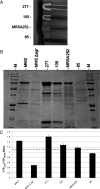Nasal carriage as a source of agr-defective Staphylococcus aureus bacteremia
- PMID: 22859823
- PMCID: PMC3448967
- DOI: 10.1093/infdis/jis483
Nasal carriage as a source of agr-defective Staphylococcus aureus bacteremia
Abstract
Inactivating mutations in the Staphylococcus aureus virulence regulator agr are associated with worse outcomes in bacteremic patients. However, whether agr dysfunction is primarily a cause or a consequence of early bacteremia is unknown. Analysis of 158 paired S. aureus clones from blood and nasal carriage sites in individual patients revealed that recovery of an agr-defective mutant from blood was usually predicted by the agr functionality of carriage isolates. Many agr-positive blood isolates produced low levels of hemolytic toxins, but levels were similar to those of colonizing strains within patients, suggesting that introduction into the blood did not select for mutations with minor functional effects. Evidently, the transition from commensalism to opportunism in S. aureus does not require full virulence in hospitalized patients. Furthermore, agr-defective mutants were found in uninfected nasal carriers in the same proportion as in carriers who develop bacteremia, suggesting low correlation between virulence and infectivity.
Figures

References
-
- Novick RP. Autoinduction and signal transduction in the regulation of staphylococcal virulence. Mol Microbiol. 2003;48:1429–49. - PubMed
-
- Fowler VG, Jr, Sakoulas G, McIntyre LM, et al. Persistent bacteremia due to methicillin-resistant Staphylococcus aureus infection is associated with agr dysfunction and low-level in vitro resistance to thrombin-induced platelet microbicidal protein. J Infect Dis. 2004;190:1140–9. - PubMed
-
- von Eiff C, Becker K, Machka K, Stammer H, Peters G. Nasal carriage as a source of Staphylococcus aureus bacteremia. Study Group. N Engl J Med. 2001;344:11–6. - PubMed
Publication types
MeSH terms
Substances
Grants and funding
LinkOut - more resources
Full Text Sources
Medical
Molecular Biology Databases

